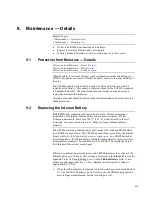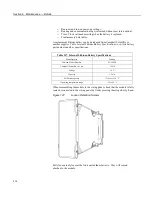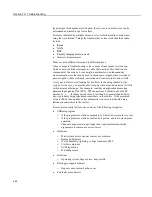
Section 8. Operation
8.10 Memory Cards and Record Numbers
Related Topics:
•
Memory Card (CRD: Drive) — Overview
(p. 89)
•
Memory Card (CRD: Drive) — Details
(p. 376)
•
Memory Cards and Record Numbers
(p. 466)
•
Data Output: Writing High-Frequency Data to Memory Cards
(p. 205)
•
File-System Errors
(p. 389)
•
Data Storage Devices — List
(p. 653)
•
Data-File Format Examples
(p. 379)
•
Data Storage Drives Table
(p. 373)
The number of records in a data table when
CardOut()
or
TableFile()
with
Option 64
is used in a data-table declaration is governed by these rules:
1. Memory cards (CRD: drive) and internal memory (CPU) keep copies of data
tables in binary TOB3 format. Collectible numbers of records for both CRD:
and CPU are reported in
DataRecordSize
entries in the
Status
table.
2. In the table definitions advertised to
datalogger support software
(p. 95),
the
CR1000 advertises the greater of the number of records recorded in the
Status
table, if the tables are not fill-and-stop.
3. If either data area is flagged for fill-and-stop, then whichever area stops first
causes all final-data storage to stop, even if there is more space allocated in the
non-stopped area, and so limiting the number of records to the minimum of the
two areas if both are set for fill-and-stop.
4. When
CardOut()
or
TableFile()
with
Option 64
is present, whether or not a
card is installed, the CPU data-table space is allocated a minimum of about 5
KB so that there is at least a minimum buffer space for storing the data to
CRD: (which occurs in the background when the CR1000 has a chance to
copy data onto the card). So, for example, a data table consisting of one four-
byte sample, not interval driven, 20 bytes per record, including the 16 byte
TOB3 header/footer, 258 records are allocated for the internal memory for any
program that specifies less than 258 records (again only in the case that
CardOut()
or
TableFile()
with
Option 64
is present). Programs that specify
more than 258 records report what the user specified with no minimum.
5. When
CardOut()
or
TableFile()
with
Option 64
is used but the card is not
present, zero bytes are reported in the
Status
table.
6. In both the internal memory and memory card data-table spaces, about 2 KB of
extra space is allocated (about 100 extra records in the above example) so that
for the ring memory the possibility is minimized that new data will overwrite
the oldest data when
datalogger support software
(p. 95)
tries to collect the
oldest data at the same time. These extra records are not reported in the
Status
table and are not reported to the datalogger support software and
therefore cannot be collected.
7. If the
CardOut()
or
TableFile()
with
Option 64
instruction is set for fill-and-
stop, all the space reserved for records on the card is recorded before the
writing of final-data to memory stops, including the extra 2 kB allocated to
alleviate the conflict of storing the newest data while reading the oldest when
the area is not fill-and-stop, or is ringing around. Therefore, if the CPU does
466
Summary of Contents for CR1000
Page 2: ......
Page 4: ......
Page 6: ......
Page 32: ......
Page 36: ......
Page 38: ......
Page 40: ......
Page 60: ...Section 4 System Quickstart Figure 16 PC200W View Line Graph 60 ...
Page 96: ......
Page 98: ...98 ...
Page 302: ......
Page 453: ...Section 8 Operation Figure 115 Using the Keyboard Display 453 ...
Page 456: ...Section 8 Operation Figure 118 Real Time Custom 456 ...
Page 457: ...Section 8 Operation 8 8 1 3 Final Memory Tables Figure 119 Final Memory Tables 457 ...
Page 458: ...Section 8 Operation 8 8 2 Run Stop Program Figure 120 Run Stop Program 458 ...
Page 460: ...Section 8 Operation Figure 122 File Edit 460 ...
Page 461: ...Section 8 Operation 8 8 4 PCCard Memory Card Display Figure 123 PCCard CF Card Display 461 ...
Page 478: ......
Page 506: ......
Page 536: ......
Page 636: ......
Page 642: ......
Page 644: ......
Page 676: ......
Page 677: ......
















































